- Learn to knit and with your left hand. This is often called continental knitting or picking. Some people use this method exclusively, so to those knitters I suggest they learn to knit with the right hand (throwing). The only time I knit with my left hand is when doing Fair Isle; then I hold a strand in each hand.
There are lots of videos on the Internet showing you how to pick or throw. Choose the method that you like best. Remember, there is no “right” way as long as the result is correct.
Here is a link (http://upload.wikimedia.org/wikipedia/commons/2/20/Howtoknit.jpg) to an image that you can print out. This illustrates how to do the knit stitch. Here is the link (http://upload.wikimedia.org/wikipedia/commons/thumb/c/c8/Howtopurl.jpg/1108px-Howtopurl.jpg> to learn how to purl.
Once you have learned the basics, keep your swatch close at hand and do a couple of rounds or rows each evening.
- Always keep the color you wish to emphasize in your left hand. Let’s say you are knitting a red and white piece and you want the red to be the dominant color. Always knit with the red in your left hand. The effect is very subtle but noticeable.
Generally, the background color is the dominant color; the foreground color will, therefore, be held in your left hand. The stitches knitted with your left hand are stretched. You cannot see it with the naked eye. This stretching causes the foreground color to pop.
—added October 22, 2013 from Celeste Young at Twisted Stitches of Central New York workshop
Don’t believe me? Knit a small piece with one color always in your left hand. After about 3", knit a couple of rows in one color to serve as a demarcation line. Now knit about 3" switching the two colors between your left and right hands. Can you see the difference?
- Keep your floats short. One way to help with this is to weave in the yarn you are carrying as you knit. (See the next tip.)
How long should your floats be? It is a matter of personal preference. Some references suggest carrying floats no more than 1"; others state no more than 5 stitches. I prefer weaving in the yarn I am carrying every third stitch. Important! Once you have decided how you are carrying your floats, work your gauge swatch in that method. Remember, each time you catch a float, the stretchiness of the fabric is reduced.
—updated October 22, 2013
- Weave in your floats. In these examples, the red (R) yarn is held in the right hand and the yellow (Y) yarn is held in the left hand.
- To weave in R, knit three sts with Y. Insert the right hand needle into the next stitch and wrap R around the right-hand needle. (Figure 1)
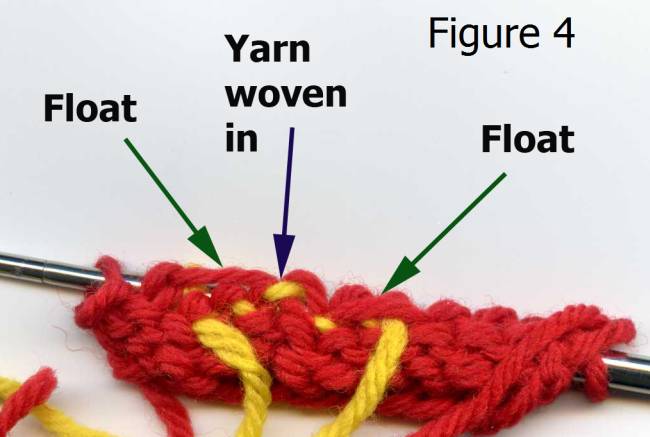 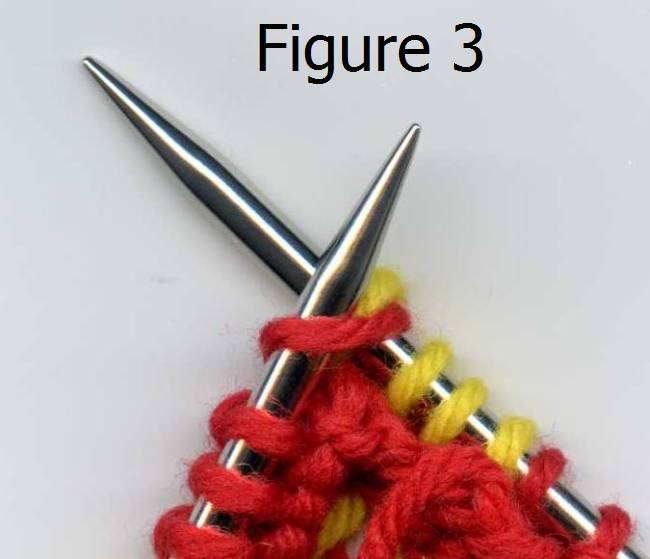 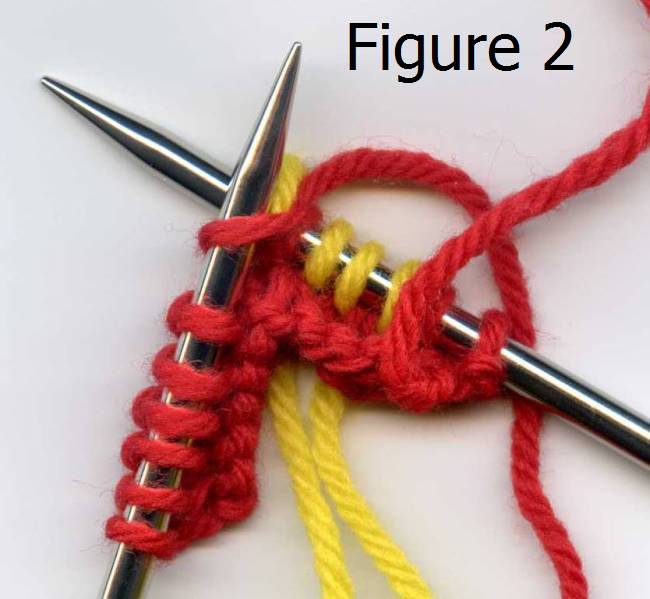 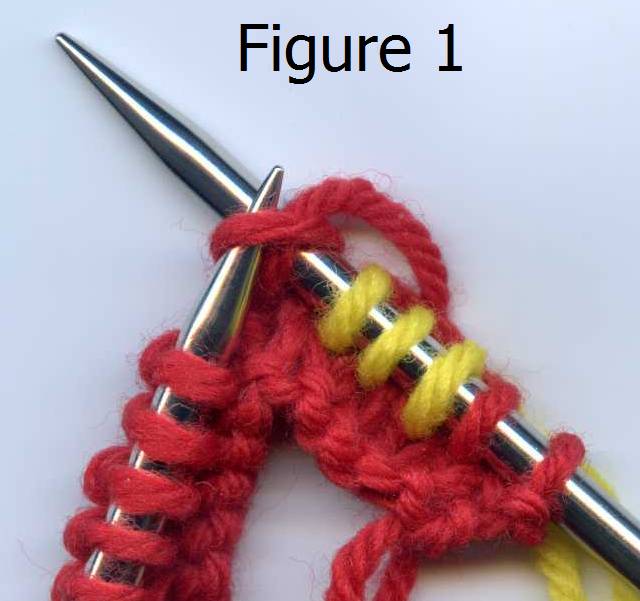
- Wrap Y around the right-hand needle. Both yarns are wrapped. (Figure 2)
- Unwrap R. (Figure 3)
- Pull Y through the stitch to knit it.
- Figure 4 shows how the back should look.
- To weave in Y, k2 with R, k2 with Y, k2 with R. Insert the right hand needle into the next stitch; lay Y over the top of the right-hand needle. (Figure 5)
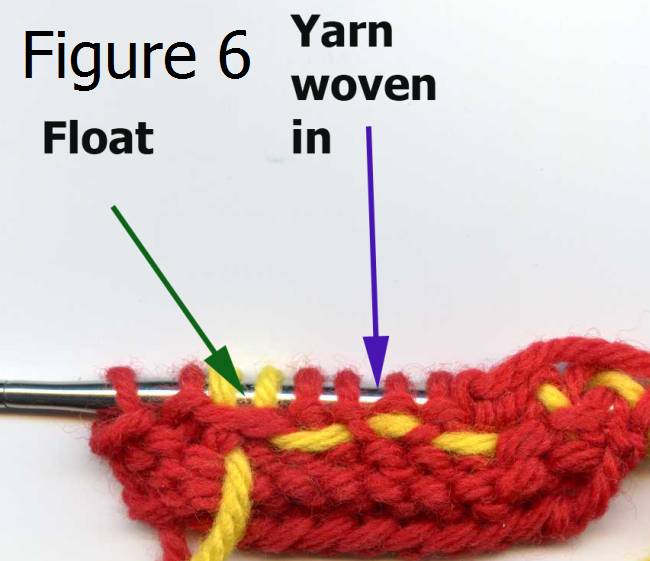 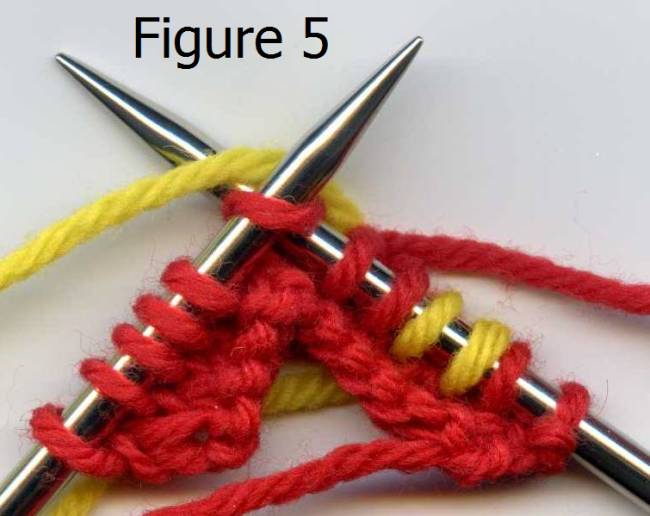
- Knit the next 2 or 3 stitches with R.
- Figure 6 shows how the back should look.
- When knitting more than 2 rows or rounds “plain” (using just one color), knit with a smaller needle. You see, when using two colors in a row, the gauge is usually a little tighter than knitting with just one color.
- If using one hand to knit Fair Isle, do not twist the yarns. Carry color A over color B and color B over color A. Twisting the yarns gives the back a braided look and affects the appearance on the front.
- Stockinette stitches result in a rectangular square. In stranded knitting, the floats in the back pull on the stitches. This results in square stitches.
—added November 21, 2013
- To avoid tight floats, spread the stitches that are near the tip of the right-hand needle before knitting the first stitch of a new color. Remember, you can always tighten up loose stitches, but cannot loosen up tight stitches.
—added November 21, 2013
- Decreasing
When decreasing for the armholes on a Fair Isle sweater, use full-fashion decreases. Because they slant outward, these decreases will help with the continuity of your pattern. At the beginning of the row, k2tog; at the end, ssk. On the purl side, ssp at the beginning of the row; at the end, p2tog. Eunny Jang has an excellent example half way down this page (http://eunnyjang.com/knit/2006/01/the_steeking_chronicles_planni.html).
—added July 3, 2014
|



